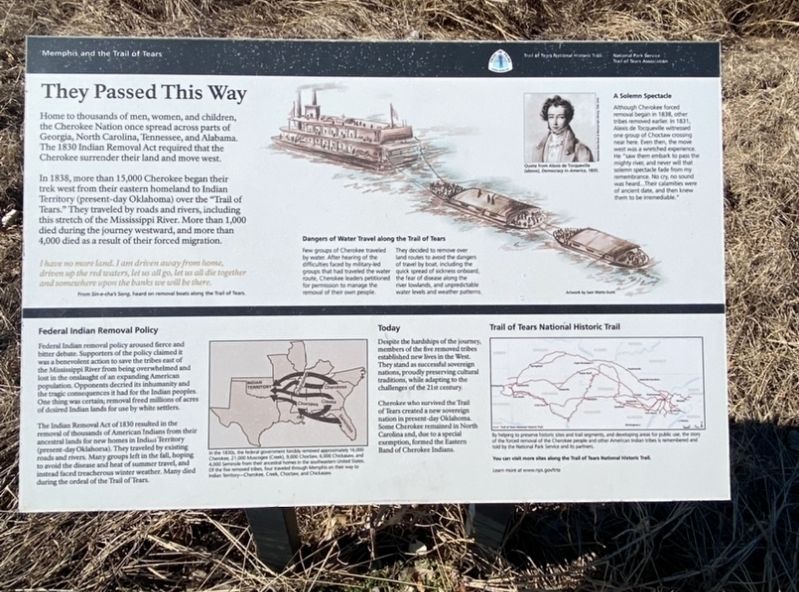Downtown Memphis in Shelby County, Tennessee — The American South (East South Central)
They Passed This Way
Home to thousands of men, women, and children, the Cherokee Nation once spread across parts of Georgia, North Carolina, Tennessee, and Alabama. The 1830 Indian Removal Act required that the Cherokee surrender their land and move west.
In 1838, more than 15,000 Cherokee began their trek west from their eastern homeland to Indian Territory (present-day Oklahoma) over the "Trail of Tears.” They traveled by roads and rivers, including this stretch of the Mississippi River. More than 1,000 died during the journey westward, and more than 4,000 died as a result of their forced migration.
I have no more land. I am driven away from home, driven up the red waters, let us all go, let us all die together and somewhere upon the banks we will be there.
Danger of Water Travel along the Trail of Tears
Few groups of Cherokee traveled by water. After hearing of the difficulties faced by military-led groups that had traveled the water route, Cherokee leaders petitioned for permission to manage the removal of their own people.
They decided to remove over land routes and avoid the dangers of travel by boat, including the quick spread of sickness onboard, the fear of disaster along the river lowlands, and unpredictable water levels and weather patterns.
A Solemn Spectacle
Although Cherokee forced removal began in 1838, other tribes removed earlier. In 1831, Alexis de Tocqueville witnessed one group of Choctaw crossing near here. Even then, the move west was a wretched experience. He "saw them embark to pass the mighty river, and never will that solemn spectacle fade from my remembrance. No cry, no sound was heard…Their calamities were of ancient date, and then knew them to be irremediable."
Federal Indian Removal Policy
Federal Indian removal policy aroused fierce and bitter debate. Supporters of the policy claimed it was a benevolent action to save the tribes east of the Mississippi River from being overwhelmed and lost in the onslaught of an expanding American population. Opponents decried its inhumanity and the tragic consequences it had for the Indian peoples. One thing was certain; removal freed millions of acres of desired Indian lands for use by white settlers.
The Indian Removal Act of 1830 resulted in the removal of thousands of American Indians from their ancestral lands for new homes in Indian Territory (present-day-Oklahoma). They traveled by existing roads and rivers. Many groups left in the fall, hoping to avoid the disease and heat of summer travel, and instead faced treacherous winter weather. Many died during the ordeal of the Trail of Tears.
Today
Despite the hardships of the journey, members of the five removed tribes established new lives in the West. They stand as successful sovereign nations, proudly preserving cultural traditions, while adapting to the challenges of the 21st century.
Cherokee who survived the Trail of Tears created a new sovereign nation in present-day Oklahoma. Some Cherokee remained in North Carolina and, due to a special exemption, formed the Eastern Band of Cherokee Indians.
Erected by National Park Service, U.S. Department of the Interior.
Topics. This historical marker is listed in this topic list: Native Americans.
Location. 35° 8.382′ N, 90° 3.626′ W. Marker is in Memphis, Tennessee, in Shelby County. It is in Downtown Memphis. Marker is on Riverside Drive, on the right when traveling south. Touch for map. Marker is at or near this postal address: 251 Riverside Dr, Memphis TN 38103, United States of America. Touch for directions.
Other nearby markers. At least 8 other markers are within walking distance of this marker. James A. Hyter, “Ol’ Man River” (here, next to this marker); John James Audubon (here, next to this marker); The John Alexander Austin House (approx. 0.2 miles away); Tom Lee Memorial (approx. ¼ mile away); Gayoso Hotel (approx. 0.3 miles away); The Grand Opera House / The New Orpheum Theatre (approx. 0.3 miles away); Spain (approx. 0.3 miles away); Tennessee (approx. 0.3 miles away). Touch for a list and map of all markers in Memphis.
Credits. This page was last revised on February 7, 2023. It was originally submitted on March 7, 2022, by Darren Jefferson Clay of Duluth, Georgia. This page has been viewed 145 times since then and 28 times this year. Photo 1. submitted on March 7, 2022, by Darren Jefferson Clay of Duluth, Georgia. • Devry Becker Jones was the editor who published this page.
Editor’s want-list for this marker. Clearer, in focus, marker photo. • A wide shot of the marker in context. • Can you help?
